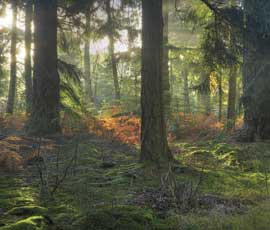Investors and timber market keep woodland prices rising

Woodland values continue to see strong gains and stand about 20% higher than two years ago, underpinned by demand from private investors and a bullish outlook for the timber market.
The rise outstrips that seen for agricultural land, with both commercial and amenity woodlands selling well, said John Clegg of John Clegg & Co, Buckinghamshire.
Prices for commercial woodland, mainly Sitka spruce in Scotland, northern England and Wales, typically range from £1,500-5,000/acre, depending on size, thinning regimes/timber volumes, location and point in the rotation.
Long-term capital appreciation is the main attraction, rather than yield, which might be as low as 1% during a rotation, compared with 4-6% a few years ago, said Mr Clegg.
“A lot of private investors are still looking for a safe home for their money. The entry point is lower for forestry than agriculture, so those wanting to invest smaller sums can still buy something very sensible.”
Another plus point is that commercial woodland requires less management than land. “Apart from harvesting and restocking, little input is needed during most of the rotation – it is a lot cheaper to look after than agricultural land.”
Most investors were looking for long-term holds. Commercial timber prices had held up despite the recession and the market outlook was firm. “The UK produces less than 40% of its requirements,” said Mr Clegg. “The outlook is largely based on world demand and once the economy picks up people believe timber values can only go one way.”
Two blocks of commercial forestry in the same area illustrated the wide range of prices, he said. Nant Yr Hwch in mid-Wales is mostly a younger second rotation crop and the 2,150-acre forest is on the market for £1,500/acre. Llannerch Yrfa Forest’s 436 acres are heavily stocked with mature timber whose sales volume can be accurately assessed. “At £5,160/acre, this is towards the top of the range.”
Demand for amenity woodland was also strong, said Mr Clegg. “People buy it for all sorts of reasons – for conservation, for family outings, as an asset for a self-invested personal pension or for some rough shooting.”
Values typically range from £3,500 to £6,500/acre, with location being a key factor. “Just like the residential market, the further you move away from London the less money there is to spend. There is a strong amenity market for up to £500,000 near London, but half that in areas like the South West.”
Size is another factor. Woods of a few acres had changed hands for £10,000/acre, said Mr Clegg.
“The smaller the block the bigger the demand – there are more people with £30,000 to spend than £300,000.”
Commercial woodlands, best described as those managed with a view to making a profit, attracted 100% business property relief on inheritance tax after two years’ ownership, he said. In addition, timber sales were free of income tax and capital gains tax was only payable on the underlying land.
“We are seeing more people at the smaller amenity end of the market putting woods back into management to take advantage of these allowances.”
Ash dieback
One unknown regarding the amenity market was ash dieback, said Mr Clegg. “I think there will be a nervousness, more on the five- to 10-acre blocks, not only with current stands but also succession cropping. Ash is the tree that squirrels least like, but if left to proliferate they’ll shred everything else.”
Overall the outlook remained strong, underpinned by the optimistic longer-term outlook for timber. “Whatever woodland people buy, commercial or amenity, they should aim to grow quality timber. It will help add value to their holding,” said Mr Clegg.
